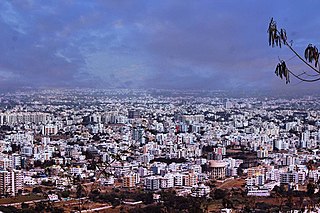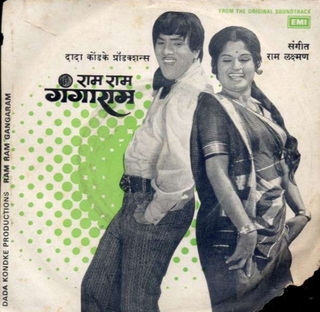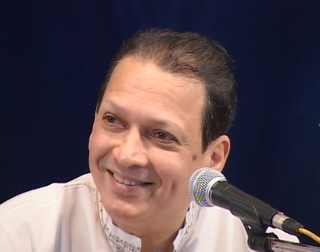The Maratha caste is composed of 96 clans, originally formed in the earlier centuries from the amalgamation of families from the peasant (Kunbi), shepherd (Dhangar), blacksmith (Lohar), pastoral (Gavli), carpenter (Sutar), Bhandari, Thakar and Koli castes in Maharashtra. Many of them took to military service in the 16th century for the Deccan sultanates or the Mughals. Later in the 17th and 18th centuries, they served in the armies of the Maratha Kingdom, founded by Shivaji, a Maratha Kunbi by caste. Many Marathas were granted hereditary fiefs by the Sultanates, and Mughals for their service.

Nashik ) is a city in the northern region of the Indian state of Maharashtra. Situated on the banks of the river Godavari. The population of Nashik city is around 2.2 million and is emerging as one of the fastest-growing cities in India. Nashik is located about 165 km (103 mi) northeast of the state capital Mumbai, and about 210 km (130 mi) north of Pune. The Mumbai-Pune-Nashik region is called the "Golden Triangle of Maharashtra". With its high agricultural production, Nashik is dubbed the Napa Valley of India and the "Wine Capital of India" as more than half of India's vineyards and wineries are located here. Around 90% of all Indian wine comes from the Nashik Valley. Nashik is one of the Hindu pilgrimage sites of the Kumbh Mela, which is held every 12 years.

Vishnu Vaman Shirwadkar, popularly known by his pen name, Kusumāgraj, was a Marathi poet, playwright, novelist and short story writer, who wrote of freedom, justice and emancipation of the deprived.
Deshastha Brahmin is a Hindu Brahmin subcaste mainly from the Indian state of Maharashtra and North Karnataka. Other than these states, according to authors K. S. Singh, Gregory Naik and Pran Nath Chopra, Deshastha Brahmins are also concentrated in the states of Telangana (which was earlier part of Hyderabad State and Berar Division), Andhra Pradesh and Madhya Pradesh (Which was earlier part of Central Provinces and Berar) Historian Pran Nath Chopra and journalist Pritish Nandy say, "Most of the well-known saints from Maharashtra, Karnataka and Andhra Pradesh were Deshastha Brahmins". The mother tongue of Deshastha Brahmins is either Marathi, Kannada or Telugu.

The Chitpavan Brahmin or the Kokanastha Brahmin is a Hindu Maharashtrian Brahmin community inhabiting Konkan, the coastal region of the state of Maharashtra. Initially working as messengers and spies in the late seventeenth century, the community came into prominence during the 18th century when the heirs of Peshwa from the Bhat family of Balaji Vishwanath became the de facto rulers of the Maratha empire. Until the 18th century, the Chitpavans were held in low esteem by the Deshastha, the older established Brahmin community of Karnataka-Maharashtra region.
Shirur is an administrative subdivision of the Pune district in the Indian state of Maharashtra. It is located on the eastern boundary of the district, on the banks of the Ghod River. The town is also called Ghodnadi to distinguish it from other locations that have the same name. Ghodnadi in Marathi Language means Ghod River.
Dadoji Kondadeo was an administrator of the Pune jagir and the nearby Kondana fort. He was appointed by Shahaji, a noble and general of the Adilshahi sultanate of Bijapur.
Prabhakar Panshikar also known as Pant was an actor on Marathi Stage. His character as Lakhoba Lokhande in the drama To Mi Navhech, written by Prahlad Keshav Atre is considered to be one of the immortal roles presented so far on the Marathi theatre. Five unique characters played in this drama To Mee Navhech made him famous in Marathi theatre and Maharashtra. He also performed Aurangzeb's role in a play Ithe Oshalala Mrutyu based on the death of Sambhaji Raje Bhosale. He was the owner of Natyasampada, a Marathi drama production organization.

Ram Ram Gangaram is a 1977 Indian Marathi-language drama film directed and produced by Dada Kondke under the banner of Dada Kondke Productions. It stars Kondke himself with Usha Chavan, Ashok Saraf and Anjana Mumtaz. The music is composed by Raamlaxman, editing is by N. S. Vaidya and cinematography is handled by Arvind Lad.
Abhinav Bharat Society (Young India Society) was an Indian Independence secret society founded by Vinayak Damodar Savarkar and his brother Ganesh Damodar Savarkar in 1904. Initially founded at Nasik as "Mitra Mela" when Vinayak Savarkar was still a student of Fergusson College at Pune, the society grew to include several hundred revolutionaries and political activists with branches in various parts of India, extending to London after Savarkar went to study law. It carried out a few assassinations of British officials, after which the Savarkar brothers were convicted and imprisoned. The society was formally disbanded in 1952.
Nashik is a historically, mythologically, socially and culturally important city in the northern part of the state of Maharashtra in India. It is known for the temples on the banks of the Godavari and it has historically been one of the holy sites of the Hindu religion. It is one of the four cities that hosts the massive Sinhastha Kumbh Mela once every twelve years.

Krishnāji Gopāl Karve was an Indian freedom fighter, a revolutionary. He had completed his B.A.(Hons) and had taken admission to LLB in Mumbai University. He was a member of the Abhinav Bharat Society in Nashik. On 21 December 1909, he along with Anant Laxman Kanhere and Vinayak Narayan Deshpande shot Jackson, the Collector of Nashik. He was sentenced to death in the Bombay high court and hanged in Thane Jail on 19 April 1910.
Arthur Mason Tippetts Jackson was a British officer in Indian Civil Services. He was a learned Indologist and a historian. He contributed many papers on Indian history, books on folklore and culture and was popularly known as Pandit Jackson. He was the Magistrate of Nasik when he was murdered by Anant Kanhere and the trial in the case led to the arrest and deportation of Vinayak Damodar Savarkar.

1909 is a 2014 Marathi movie based on the assassination of British officer Arthur Jackson by Anant Kanhere. Directed by Abhay Kambli, the film is set in the year 1909, during the period of British dominion over India and focuses on the young revolutionaries' efforts to drive the British out of the country and gain freedom.

Vidyadhar Oke is an Indian doctor, musicologist, harmonium player, and astrology consultant, who has done research in the use of shrutis (microtones) in Indian classical music and created a unique 22-shruti version of the harmonium.

Bharatiya Digital Party is a Marathi YouTube Channel, popularly known as BhaDiPa. They are known for their comedy and music videos. As of October 2018, it had 150 million views across their Facebook page and YouTube Channel and more than 1.5 Million subscribers on YouTube. The channel was founded by Sarang Sathaye, Anusha Nandakumar and Paula McGlynn.
North Maharashtra is a geographical region of Maharashtra State, India. The region is composed of Nashik, Dhule, Nandurbar, and Jalgaon districts. It borders the state of Gujarat to the northwest, Paschim Maharashtra to the south, Konkan to the west, and the Vidarbha and Marathwada regions of Maharashtra to the east.
Vaman Narayan Joshi also known as Daji was an Indian freedom fighter and revolutionary from Maharashtra. He is known for his involvement in the assassination of Nashik's district collector, A. M. T. Jackson, as Joshi trained Anant Laxman Kanhere, who carried out the killing of Jackson. Following Jackson's assassination, Joshi was arrested and sentenced to life imprisonment. He became a prominent figure in the revolutionary movements of his time.











